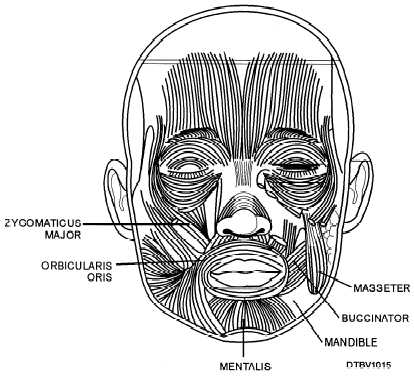The TMJ consists of three bony parts:
Glenoid fossa - Oval depression in the temporal bone that articulates with the mandibular condyle.
Articular eminence - Ramp-shaped segment of the temporal bone located anterior to the glenoid fossa.
Condyle - The knuckle-shaped portion of the mandibular ramus found on the end of the condyloid process. It is positioned underneath the glenoid fossa and makes up the hinge joint of the TMJ.
MUSCLES OF THE HEAD
The muscles of the head can be classified into two groups, muscles of facial expression and muscles of mastication. How muscles work and function depends on the action of each muscle (movement), the type of joint it is associated with, and the way the muscle is attached on either side of the joint. Muscles are usually attached to two places: one end being joined to an immovable or fixed portion, and the other end being joined to a movable portion on the other side of a joint. The immovable portion is called the origin of the muscle, and the movable portion is called the insertion. When muscles of the head contract, the insertion end is pulled toward the origin.
MUSCLES OF FACIAL EXPRESSION
The muscles that are underneath the skin of the face are responsible for helping communicate our feelings through facial expression. The muscles of the mouth help us express surprise, sadness, anger, fear, and pain. Table 3-3 lists the muscles of facial expression and figure 3-15 illustrates these muscles.
MUSCLES OF MASTICATION
Mastication is defined as the process of chewing food in preparation for swallowing and digestion. Four pairs of muscles in the mandible make chewing movements possible. These muscles can be grouped into two different functions. The first group includes three pairs of muscles that elevate the mandible to close the mouth as in biting down. The last group includes one pair that can depress the mandible (open the mouth), make grinding actions side to side, and can make the mandible go forward in a protruding motion. Table 3-4 lists the muscles of mastication and figure 3-16 illustrates these muscles.
ORAL STRUCTURES OF THE MOUTH
The oral cavity (mouth) contains various structures that aid in the digestion process of food and also serves as an organ of speech and sensory

Figure 3-15. - Anatomy of muscles of facial expression.
Continue Reading